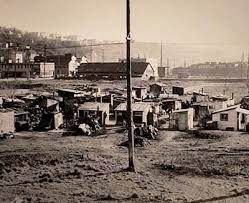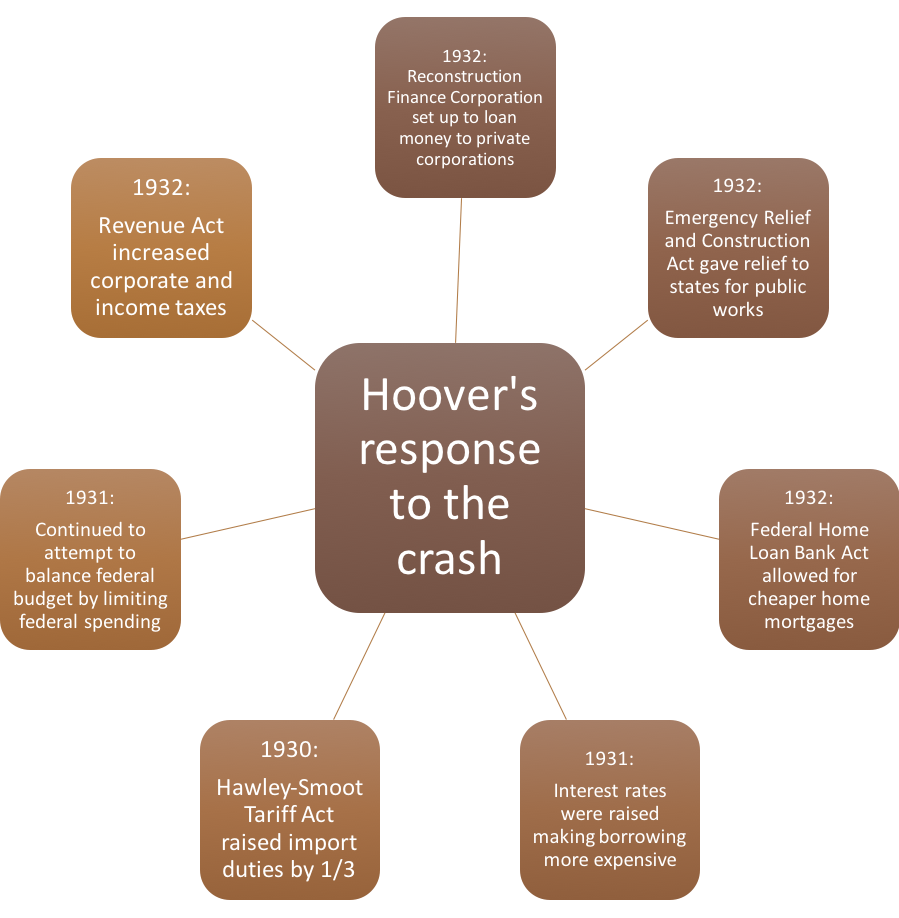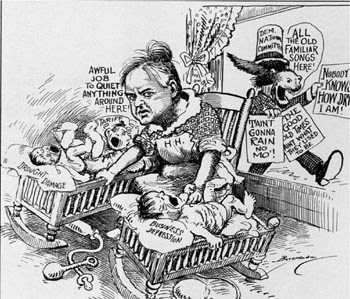d. Hoover's response to the Depression
.jpg)
Hoover's approach to the Depression was guided by his firm views in 'laissez-faire' economics. As Hugh Brogan writes. 'Hoover [was not] inhumane. But he had always been an ideologist, who believed in what he called American individualism'. This approach meant that he policies were inadequate for coping with the enormity of the economic crisis.
Guiding questions:
What were the economic effects of the Depression by 1932?
What was President Herbert Hoover’s response to the depression?
What was the response to Hoover's policies?
Was President Herbert Hoover’s response to the economic crisis in the US effective?
Why did Roosevelt win the 1932 election?
Depression
By the winter of 1932 America was in deep economic trouble. In 1932:
- Twelve million people were out of work; that is a quarter of the country's entire work force
- The number of people out of work every day was going up at teh rate of 12,000 every day
- 20,000 companies went bankrupt
- 1616 banks closed down
- One farmer in every twenty was thrown off his land for failure t make mortgage repayments
- 23,000 people committed suicide, the largest yearly figure in American history
Watch the first 6 minutes of this video. People's Century - Breadline, to get an overview of the consequences of the Depression.
This video can also be found on vimeo here
Here are the timings for this video in case you wish to explore the impact of the Great Depression in other countries:

Farmers were hit particularly severely. Many could not pay their mortgages and had their farms seized, taking to the road to get work wherever they could. Those who had not owned their own farms in the first place - Black farmers and laborers were often even worse off.
The situation got dramatically worse when over farming in the Southern and Midwest states caused the topsoil to turn to dust. This was whipped up by the wind to create a huge dust bowl making life intolerable. Many farmers headed to California.

The rapid rise in unemployment also led to homelessness in the cities. Many ended up on the streets - queueing for food handed out by charities (see photo at the top of the page). A large number of men travelled by railways from city to city looking for work.
In every city, Hoovervilles developed. This was a shanty town of quickly built huts made from corrugated iron and other bits of rubbish that people could find.
How did the Great Depression impact the US?
In groups of four research the impact of the Great Depression on different sectors of the US economy up to 1933. Your group will create an information pamphlet for a museum exhibit on the short term impact of the economic crisis. You will need to find and cross-reference statistical data. Attempt to find visual representations of the impact of the depression.
- Bank failures
- Business failures
- Car sales
- Decline of steel industry
- Decline of construction
- Farm incomes and wheat prices
- Farmers losing land
- National unemployment
.jpg)
A Hooverville (Shanty town) in Seattle,
What is the message of this photograph?
‘During the war [First World War] we necessarily turned to the government to solve every difficult economic situation… If continued in peacetime it would destroy our progress and freedom… it would have meant the undermining of individual initiative and enterprise.’ President Hoover
‘It has been said that the jury on the Hoover presidency is still out – that scholars who seek to assess American presidents react differently depending on their sources of information, their times and their values.’
Historian Martin L Fausold, The Presidency of Herbert C Hoover.
As you will have found in your group research on the impact of the depression, the economic crisis led to millions of Americans losing their jobs and thousands were forced to leave home and move around the country in search of work. The middle classes lost their savings, banks collapsed, people lost their homes and farms were repossessed. Churches and charities set up soup kitchens in towns and cities and as the crisis continued a mood of despair took hold. The suicide rate in the US rose to its highest level, an increase of 14% between 1929 and 1932.
As unemployment rose the problem for government was who would provide support, and if it was the government how would it finance this? It could raise taxes or it could increase government debt. In addition, as banks closed, businesses failed and farmers became destitute, would the government provide loans to forestall closure and collapse?
President Hoover’s core philosophy regarding government was that it should follow a principle of ‘laissez faire’ and that there should not be any expansion of federal government power. Hoover’s Secretary of the Treasury, Andrew Mellon, advised the President to do nothing. Mellon believed that the crash was a correction in the system and that bad companies forced to close would free up investment for more promising and profitable ventures. Less effective people would be replaced by the more competent and in general people would work harder. The system would correct itself and there would be a recovery.
Although he had experience as an administrator of relief programs before he became president, Hoover took on board this advice and believed that voluntary assistance to those in need would be sufficient until the economy recovered. Hoover offered support to the financial structure but did not offer direct assistance to individuals. He did not want to undermine the ‘American character’ of individualism and self-sufficiency.
Hoover believed that the role of government should be to coordinate rather than take direct action. He referred to the US constitution which gives states rather than federal government responsibility for welfare. When the depression took hold in the US only 8 states had unemployment compensation, which meant the unemployed had to rely on charities.
Hoover’s initial policy was to support ‘voluntaryism’. This policy was in line with his belief in individualism and self-reliance and Hoover argued that as relief was the responsibility of local government federal interference would damage self-government. He promoted the idea that local politicians should take action. The mayor of Detroit created food stations for 14,000 people after his election in 1930. Governor Franklin Roosevelt organized relief for the poor in New York which garnered him a national reputation.
Hoover did not look for domestic causes of the depression and argued that the international economic situation was to blame; the collapse in international trade and conditions in Europe were dictating the crisis and that the Federal government could do little to affect it.
In pairs read the following source. The source is the transcript of the response of President Herbert Hoover to a question from the press about the need for a special session of the US Congress to address the issues of unemployment.
What can you learn from this source, and the source above, regarding Hoover's understanding of the situation in the US at this time?
President Hoover. October 24, 1930.
No Special Session is necessary to deal with employment. The sense of voluntary organization and community service in the American people has not vanished. The spirit of voluntary service has been strong enough to cope with the problem for the past year and it will, I am confident, continue in full measure of the need...
In fact, Hoover did not ignore the USA's economic problems, but many of the measures he introduced failed to meet the needs of the time.
In pairs read through the chart below that outlines the measures taken by Hoover in response to the economic crisis. Discuss with a partner which measures you think may have a] been effective b] been ineffective or made the situation worse c] were too limited to have an effect.

As you will have seen in the diagram above, some of Hoover's measures were useful, such as the Emergency Relief and Construction Act which gave relief money to states for federal and local public works, and the Federal Home Loan Bank Act which helped people give mortgages. The Reconstruction Finance Corproation had power to lend up to $2 billion to rescue banks and insurance companies. 90% of loans went to small and medium-sized banks. [FDR continued to use RFC to combat depression].
However, the rise in interest rates made borrowing more expensive and reduced the amount of money available for spending - just when more spending was needed. The Hawley-Smoot Act of 1930 meanwhile raised import duties by one-third despite protest letters from a thousand economists. If foreign countries could not sell profitably in the USA they could not earn enough dollars to repay war debts to American bankers
The Revenue Act of 1932 increased corporate and income taxes making it harder for industry to expand and take on more workers.
For the general public Hoover’s response to the economic crisis was totally insufficient. By the time of his defeat in the 1932 Presidential election, Hoover had become one of the most unpopular presidents in US history. As you have read above, the shanty towns made of old packing cases and scrap metal to form makeshift dwellings for the homeless in urban areas were termed ‘Hoovervilles’ and old newspapers were called ‘Hoover blankets'.

Cartoon by Clifford Kennedy Berryman, 1930,
- What does the cartoon above reveal about the issues and pressure Hoover faced up to 1932?
- Research other cartoons which comment on Hoover. Print one off and annotate to show its message.
Protest and opposition to Hoover’s response to the depression grew. This culminated in the ‘Bonus Army March’ in 1932, where nearly 43 000 marchers, many of whom were veterans of the First World War and who had been unemployed since the start of the depression, marched to Washington D.C. to demand cash redemptions of their service certificates.
Watch the following clip, make notes on the government’s response and discuss with a partner the impact this event may have had on President Hoover’s government.
The Hoover government’s response to the Bonus Marchers in 1932 seemed overly harsh; after Congress had turned down the veterans' request to be paid their bonus then rather than waiting until 1945, the government used the army to clear them away. General MacArthur moved 21 000 veterans and families from their shanty towns. As you saw on the clip, the use of tear gas, tanks and cavalry shocked the nation. The burning of the make-shift homes, filmed with the White House in the background, seemed to suggest that the US was on the brink of civil war.
In groups of three research the protests outlined in the chart below that manifested against the Hoover government’s apparent inaction during the crisis.

“We didn’t admit it at the time, but practically the whole New Deal was extrapolated from programs that Hoover started.”
Rexford Guy Tugwell, a key policy advisor to Franklin Roosevelt’s administration.
The following points highlight key criticisms of Hoover's polices:
- His measures did not go far enough
- He only began to take direct federal action after ‘voluntaryism’ and state action had failed.
- His measures were ‘too little, too late’
- By 1932 Hoover’s Federal Farm Board had failed. The collapse of global grain prices meant the measure was not effective
- His moratorium on inter-Allied debt failed as Europe already in deep depression
- He did nothing to help the majority of ordinary Americans
However, although you have considered the ways in which President Hoover’s response to the depression was ineffective, it should be taken into account that he faced an unprecedented economic crisis – a situation that was much more complex and severe than previous economic slumps. In addition, there is evidence to suggest that some of the measures he took were in fact effective.
- He had some success in persuading business to act themselves; some froze wages to prevent further lay-offs, although this had limited success. US steel introduced 10% wage cuts by 1931.
- In 1929 [pre-crisis] An Agricultural Marketing Act established a nine man Federal Farm Board with funds of $500 million to create farming cooperatives. In 1930 Hoover created the Grain Stabilization Corporation which brought surplus wheat from cooperatives as a way of stabilizing grain prices.
- Hoover dramatically increased government spending for subsidy and relief schemes. From 1930 to 1931, the federal Government spending increased, and its share of GNP soared from 16.4 percent to 21.5 percent.
- He changed policy after he became aware that voluntaryism was failing. He created the Reconstruction Finance Corporation, approved by Congress in Jan 1932 (see above).
- The Emergency Relief and Construction Act was passed to help unemployed (see above).
- The Federal Home Loans Act created Federal home loans banks to provide up to 50% assistance for people who could not pay off their mortgages.
Orthodox writers such as Charles Kindleburger (1986) argue that the Depression would have ended sooner and its impact been less severed if Hoover's administration had been more willing to help the struggling banks.
Paul Boyer (1995) argues that Hoover's inability to accept the responsibility of the US for the crisis was key: 'Hoover blamed the Depression on global forces and argued that only international measures would help' (Boyer, P et al. 1995)
James Patterson challenges this view stressing that Hoover called for federal intervention, cancelled war debt payments to the US, sped up work on the Boulder Dam and approved the creation of the Reconstruction Finance Corporation
Hugh Brogan acknowledges the measures that were introduced but argues that they were not enough and that Hoover did nothing for the majority of the American population.
Hoover's Democrat rival in the 1932 US election was Franklin D Roosevelt.
FDR had been the assistant secretary for the Navy under President Woodrow Wilson during the First World War and had been the Democrats' vice presidential candidate in 1920. However, his political career seemed to come to an abrupt end when he contracted polio in 1921 and lost the use of his legs. Overcoming his disability, FDR won the governorship of New York state in 1928. It was clear he was very different to Hoover in his approach to the depression
As the depression took hold after 1929 he acted decisively to aid the poor and unemployed in his state of New York
He spoke about the 'forgotten man at the bottom of the economic pyramid' and was shocked to see 'millions living in conditions labelled indecent half a century ago'
He called for a ‘bold experiment’ to end the depression; a 'New Deal' for the American people showing that he was prepared to take direct action. He was also not afraid to ask for advice on important issues from a wide range of experts such as factory owners, union leaders and economists
These factors won over the support of both working people who saw hope in his message and middle class people who were afraid of revolution due to the growing protests also decided that Roosevelt's policies might help prevent the violence on the streets.
The election was a landslide victory for Roosevelt. He won 7 million votes and the Democrats won a majority of seats in Congress. it was the worst defeat the Republicans had ever suffered.
What can you learn from each of these sources about the reasons for Roosevelt's victory in 1932?
Source A
From an election speech Roosevelt gave in 1932
If starvation and dire need on the part of our citizens make necessary the appropriation of additional funds which would keep the budget out of balance, I shall not hesitate to tell the American people the full truth and ask them to authorise the expenditure of that additional amount.
Source B
From 'Depression the and New Deal' by R Smalley, 1990
Roosevelt showed confidence. The Democratic candidate's smile and optimism proved far more popular with the electorate than Hoover's grim looks. This difference in presentation was important because in some ways the two candidates appeared to have similar policies.
Source C
A journalist writing about the Bonus Army March, 1932
Never before in this country has a government fallen to so low a place in popular estimation or been so universally an object of cynical contempt. Never before has a president given his name so freely to toilets and offal dumps, or had his face banished from the cinema screen to avoid the hoots and jeers of children
In 1932, the US election was between Hoover and the Democrat, FDR Roosevelt.
Divide the class into half. One half should write a speech for Hoover's election campaign setting out the reasons why people should still vote for Hoover.
The other half should write a speech for Roosevelt's election campaign setting out the failures of Hoover's policies and offering an alternative approach.
Take it in turns to read out your speeches.

 IB Docs (2) Team
IB Docs (2) Team
